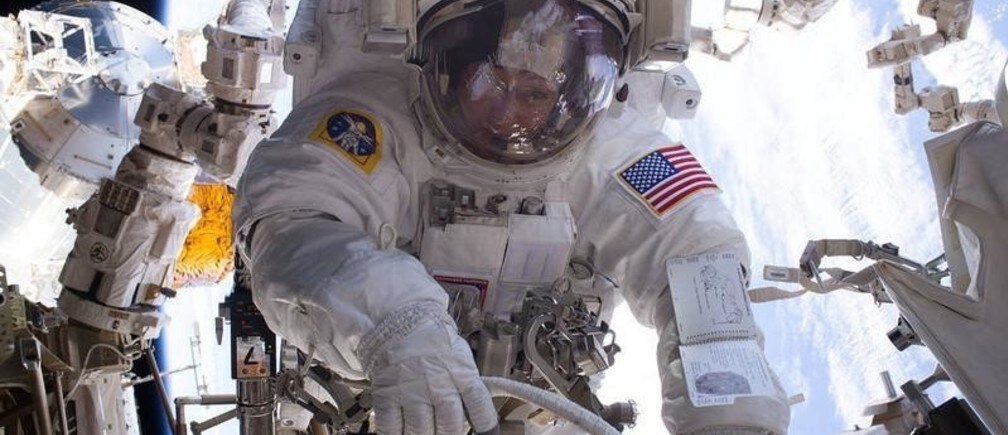Countdown: What will 2030's new space economy look like?

We stand on the brink of returning to space – this time, to stay Image: NASA/Handout via Reuters

Get involved with our crowdsourced digital platform to deliver impact at scale
Stay up to date:
Fourth Industrial Revolution
In 1972, the late Gene Cernan, the last man to walk on the moon, got back into the lunar module and promised: “We shall return in peace and hope for all mankind.” By 2030, humans will once again walk on the surface of the moon, this time fueled by a revolution in how we move beyond Earth. In 2017, it is the private sector working with the public sector that is fueling the move from the surface of the planet to low-Earth orbit, to the surface of the moon, and on to Mars. Unlike the Apollo program, which was primarily led by the United States government, this new wave of humanity beyond Earth will involve partnerships between government space agencies and the private sector.
What will 2030 look like? The International Space Station will probably have been deorbited after demonstrating the value of research in microgravity to fields ranging from the production of high-performance optical fiber to development of new vaccines, and drugs to treat osteoporosis. As demonstrated by the test of the Bigelow orbital module, the next wave of stations in low-Earth orbit may be public-private partnerships, with a new economic development zone fueling a range of activities from space tourism to space manufacturing. Private-sector satellites will help keep the space above Earth clear, removing space debris and helping with refueling.
Earth observations, by both the private sector and government space agencies, will continue to help countries build climate resilience, provide data to ensure water and food security, and monitor and predict climate refugees. Satellites may be available to order from companies like Amazon, and launched on airline-like weekly schedules, allowing affordable access to space from countries and companies from around the world. Downstream application of Earth observation data will continue to grow, spurring innovation and job creation.
Back on Earth, rocket-propelled and combined-cycle passenger vehicles will enable planet-crossing trips in minutes rather than hours. Affordable broadband communication will be possible from any point on Earth (and above it), helping to bring billions of people into the global economy. Precise space-based navigation will enable local transport via drones and personal electric aviation that fundamentally changes the delivery of people and goods across cities.
NASA and its partners from international space agencies and industry will be finalizing the shakedown cruise of their Mars transit vehicle in orbit around the moon, where they have developed sustainable environmental-control and life-support systems that will enable a three-year mission to Mars and back beginning in 2032. The first human landings on Mars will take place before the end of the 2030s, as space agencies and private companies work together to develop entry, descent and landing systems to land the required large mass of equipment and supplies on the surface. Indications of life may have been already discovered by scientific rovers and landers, increasing the imperative to have scientists on the surface to confirm the first evidence of extraterrestrial biology.

On the surface of the moon, we are likely to see the initiation of a private-public base, following on from Google’s Lunar XPRIZE competition, moving to develop a lunar economy. From access to minerals to space tourism, the moon will be the next economic development zone in space, with the private sector leading the way. Meanwhile, scientists and private companies will be exploring asteroids in search of knowledge about our origins and valuable resources.
The new space economy of 2030 will provide huge benefits, from pushing technologies as we find ways to live sustainably beyond our planet, to improved Earth observations to help protect and preserve life back home, to creating new jobs, companies and opportunities. While it has been 45 years since Gene Cernan left the moon, we now stand on the brink of returning to space – this time, to stay.
This blog is the first in a series of posts by the World Economic Forum’s Global Future Council on Space Technologies. The series will focus on the future and importance of space for governments, business, society, and the individual.
Don't miss any update on this topic
Create a free account and access your personalized content collection with our latest publications and analyses.
License and Republishing
World Economic Forum articles may be republished in accordance with the Creative Commons Attribution-NonCommercial-NoDerivatives 4.0 International Public License, and in accordance with our Terms of Use.
The views expressed in this article are those of the author alone and not the World Economic Forum.
Related topics:
The Agenda Weekly
A weekly update of the most important issues driving the global agenda
You can unsubscribe at any time using the link in our emails. For more details, review our privacy policy.
More on Fourth Industrial RevolutionSee all
Bart Valkhof and Omar Adi
February 16, 2024
Anna Maria Collard
February 12, 2024
Adele Peters
February 8, 2024
Daniele Battaglia
February 6, 2024







